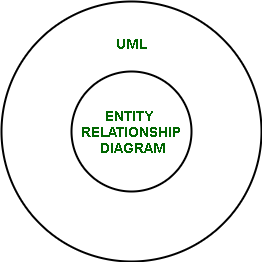1.统一建模语言(UML):
UML 是一种建模语言,可以直观地表示软件系统。
2. ER图:
ER 图是现实世界实体及其相互关系的图形表示。
 UML和ER图的区别:
UML和ER图的区别:
| S. No. | CATEGORY | UML | ER diagram |
|---|---|---|---|
| 1. | Full Form | UML stands for Unified Modelling Language. | ER Diagram stands for Entity Relationship Diagram. |
| 2. | Definition | It is a general modelling language which is used to visualize the design of a software system. | It is a pictorial representation of the real-world entities and their relationships with each other. |
| 3. | Relationship | It is the parent of ER diagram. | It is the child of UML. |
| 4. | Use | It is used to design the entire software. | It is used to design only the databases. |
| 5. | Scale | It is mainly used in case of large-scale software development. | IT can be used in case of database development of all scales. |
| 6. | Components | It has use cases and workflows. | It has entities, attributes and relationships. |
| 7. | Diagrams involved | It involves use case diagrams and activity diagrams. | It is itself involved in representation. |
| 8. | Primary User | It is used by developers to understand flow of program. | It is made for the understanding of Stake holders and enterprise owners, to understand that their requirements have been correctly met. |
| 9. | Depiction | Flow of control is depicted. | Relationships are depicted. |
| 10. | Modelling | It is a form of dynamic modelling as it can depict what activities are being performed at what time. | It depicts static modelling (as unlike UML it does not depict state of the activities). |
| 11. | States | It involves a final and an initial state. | It has no state representation. |
| 12. | Shapes used | It is uses circles, rectangles with round corners, arrow heads, diamonds, rectangular bars etc. | It uses only 3 shapes (oval, rectangle and diamond). |
| 13. | Use of swimlanes | It uses swimlanes. | It does not use swimlanes. |
| 14. | Time | It can represent time taken during activities. | It does not depict time. |
| 15. | Types | It is of 2 types, Structural UML diagrams and Behavioral UML diagrams | It does not have types, however, it contains entities, relationships and attributes each of which have several types. |